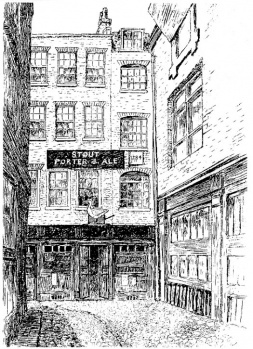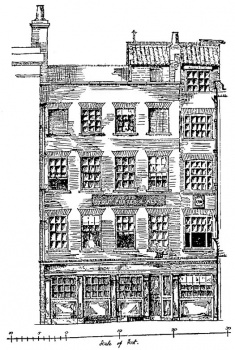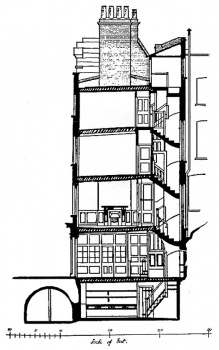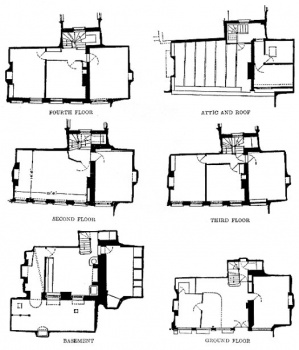En:Goose and Gridiron Ale-House
Goose and Gridiron
Source: Phoenixmasonry
By Ralph Omholt
(Seattle, Washington - USA)
The Goose and Gridiron Ale-House was located in a section of London known as St. Paul's Churchyard. The name was a corruption, or parody, on the arms of the "Swan and Lyre," a musical society which also met at the ale-house. The building was constructed with five floors, including the basement. The largest dining room, on the second floor, measured only 14 2 by 21 2 feet in area.
Masonic history records the beginning of the Grand Lodge of London and Westminster as being organized there on June 24, 1717, by a combined meeting of four local area Lodges. One of Lodges among the original 'Four Old Lodges' met there, assuming the name of the ale-house.
Dr. Anderson tells us that a Grand Lodge 'pro tempore' was formed at the Apple Tree Tavern in 1716, with no Grand Master elected and with no regulations or laws of any kind formulated. This meeting amounted to an agreement to meet the following June 24th to form a Grand Lodge, at the Goose and Gridiron Alehouse.
The famous meeting of June 24, 1717 (birthday of St. John the Baptist) was the designated as the Annual Assembly and Feast. Three additional annual meetings were subsequently specified by the original General Regulations; one on Michaelmas (in September), one just after Christmas (December 27 - birthday of St. John the Evangelist), and another on Lady Day (Annunciation Day, March 25). There is no record that these specified meetings actually occurred.
At the organizational meeting, the four Lodges elected Anthony Sayer, as the 'oldest Master Mason and then Master of a Lodge', as its Grand Master, agreeing to hold a 'Grand Feast' once a year. Sayer appointed his Grand Wardens and 'commanded the Master and Wardens of Lodges to meet the Grand Officers every Quarter in Communication.' It is worthy to note that the organization started, with only those two purposes. The modern "Craft" started with a planned party!
The four original Lodges which effected the formation of the Premier Grand Lodge are referred to as 'The Four Old Lodges.' They were known by the names of the taverns or ale houses where they met. The distinction between ale-houses and taverns, if there was any, is probably inconsequential.
Four Old Lodges
Dr. Anderson lists the 'Four Old Lodges' as:
- At the Goose and Gridiron Ale-house in St. Paul's Churchyard.
- At the Crown Ale-house in Parker's Lane near Drury Lane.
- At the Apple-Tree Tavern in Charles Street, Covent Garden.
- At the Rummer and Grapes Tavern in Channel Row, Westminster.
The original List of Lodges, published in 1725, displayed a pictorial representation of the name or sign of the tavern or ale house where each of the lodges met, in addition to the appropriate names of the locations or the streets and the meeting nights. The first on the list was represented by a picture of a Goose and Gridiron, opposite of which were the words, "St. Paul's Churchyard, every other Mond from ye 29th of April inclusive."
Coil's Encyclopedia informs us that the lodge which originally met at the Goose and Gridiron Ale house in 1717 continued to meet at that location until 1729. It then moved to the King's (or Queen's) Arms Tavern in the same area of London, where it remained for an extended period of time. On the Engraved List of Lodges of 1760, it assumed the name, "West Indian and American Lodge." In 1770, this name was changed to the "Lodge of Antiquity."
In the 1770s, William Preston ('father' of the Masonic Monitor), Masonic writer and ritualist, was elected its Master, giving the Lodge renewed esteem and dignity. Later, the Duke of Sussex and the Duke of Albany each became Master of the Lodge for several years. While the name has been changed, the descended Lodge is still active. It currently meets at the Freemason's tavern and the Freemason's Hall in London.
While the ale-house was torn down, the physical symbol of the goose was retained in the Masonic archives. Despite a variety of drawings which depicted it's image with reasonable accuracy, the archivists were surprised to discover that the goose was actually standing in a crown. The original symbol has recently been restored.
In the interest of justice, the history of the remaining three Lodges is also warranted.
The second Lodge
The second Lodge which originally met at the Crown Ale-house is believed to have originated in 1712. It later moved to Queen's Head Tavern, Turnstile, Holborn in the year 1723. It then moved to the Green Lettice, Rose and Rummer, and then to the Rose and Buffloe. In 1730, the Lodge met at the Bull and Gate, Holborn. The Lodge last appeared on the Engraved List of 1736; struck from the roll in 1740. An application for its restoration was later submitted and denied on the grounds that none of the petitioners had ever been original members of the Lodge during the term of its original existence. Thus, the tragic demise of one of the Four Old Lodges.
The third Lodge
The third Lodge which originally met at the Apple Tree Tavern on Charles Street, Covent Garden in 1717 moved to the Queen's Head, Knaves Acre in approxiamtely 1723. According to Dr. Anderson Constitutions of 1738, after the move to the Queen's Head, there was some form of disagreement between the members resulting in a new constitution for the Lodge. Given that none of the original 'Four Old Lodges' was expected to hold warrants, Dr. Anderson's information implies that there must have been a break in the continuity of this Lodge, necessitating a new authorization. However, the known history does not imply that there was a significant interruption as had occurred with the Crown Lodge.
Unfortunately, Masonic history has not been kind to the Lodge. At some time before 1755, the Lodge moved to the Fish and Bell, on Charles Street, Soho Square, there it remained until 1768. In 1768, the Lodge moved to the Roebuck, on Oxford Street, under the name of "Lodge of Fortitude," remaining there until 1793. In 1818, it merged with the Old Cumberland Lodge (constituted in 1753). It since been known as the "Fortitude and Old Cumberland Lodge No. 12." The changes name and status caused such confusion that the identity of the Lodge was lost for nearly a century. The root of the confusion began with the acceptance of the new warrant in about 1723. The new warrant led to the inference that it was originally organized in that year. In substance this Lodge appears to be the old Apple Tree Lodge. However it was apparently technically ruled to be a new lodge, having had a warrant forced upon it.
Such is a tragedy of Masonic history, as the preliminary meeting for the organization of the Premier Grand Lodge was held at the Apple Tree Tavern in 1716, with the first Grand Master, Anthony Sayer, a member of the Lodge.
The fourth Lodge
The fourth Lodge which met at the Rummer and Grapes in 1717 had George Payne, the second and fourth Grand Master, Dr. Desaguliers, the third Grand Master, and several others who became Grand Masters, together with Dr. James Anderson, as members. The Lodge moved to the Horn Tavern in 1723, taking the name, "Horn Lodge." In 1764 a new Lodge was formed at the Horn, with the effect of the decline of the old Lodge. In 1774, it consolidated with Somerset House Lodge. In 1818, it once again consolidated with a younger lodge, "Royal Inverness Lodge". The old Lodge now works as "Royal Somerset House and Inverness Lodge No. 4."
Most studies of Freemasonry make reference to an old tavern in which the early Masonic Lodges held their meetings. It was natural in those days, that men sought the tavern as a community center where the need for camaradarie was satisfied. Men gathered to drink, to talk and generally, to enjoy themselves. The tradesmen, merchants, landowners and people generally, met to discuss the happenings of the country and the community in these taverns. It was natural then, that the tavern became the civic center and the primary source of social and intellectual activity within each community.
Four of these taverns, the best known being the Goose and Gridiron, were the meeting places of the four lodges which united to form the Grand Lodge of England, the mother Grand Lodge of all the world, in 1717. The owner selected as his sign, a goose striking the bars of a gridiron with its foot. John Ross Robertson visited this tavern in 1897 just prior to its demolition. He later gave a vivid description of it in his History of Freemasonry in Canada.
Regrettably, the Goose and Gridiron was not preserved, but as a testament to the original meeting place of modern freemasonry.




